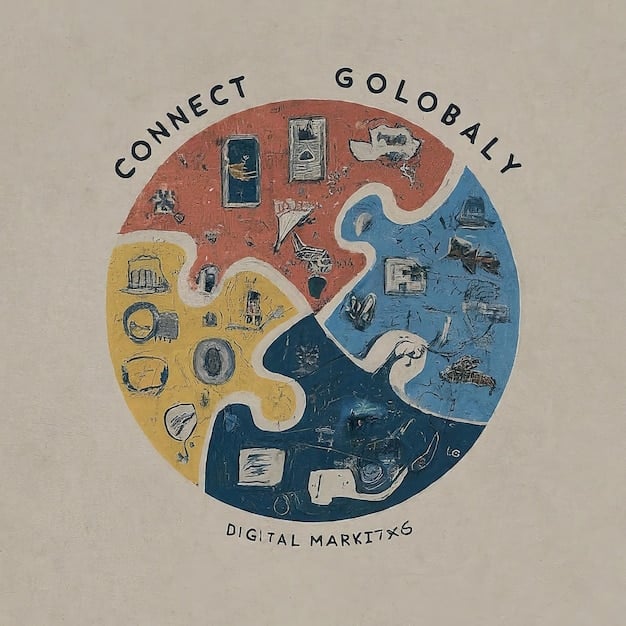Tokenized Journalism: Transforming Editorial Decisions with Blockchain Voting

Tokenized journalism leverages blockchain technology to foster transparent and democratic editorial decision-making through tokenized voting, potentially revolutionizing how news is produced and consumed in the US.
The media landscape is constantly evolving, and the rise of blockchain technology presents exciting new possibilities. One such possibility is **tokenized journalism**, which explores the use of tokenized voting for editorial decision-making in the US. This innovative approach could reshape how news is created and curated, empowering readers and challenging traditional gatekeepers.
Understanding tokenized journalism
Tokenized journalism represents a paradigm shift in how news content is created, managed, and consumed. At its core, it integrates blockchain technology, specifically tokenization, into various aspects of journalism. This approach aims to enhance transparency, decentralization, and audience engagement, ultimately leading to a more democratic and trustworthy news ecosystem.
What is Tokenization?
Tokenization involves converting rights to something into a digital token that can be traded on a blockchain. In the context of journalism, these tokens can represent various elements, such as voting rights on editorial decisions, ownership of content, or even rewards for contributing to the news process.
Key Benefits of Tokenized Journalism
By leveraging blockchain, tokenized journalism offers several potential advantages. These include increased transparency in editorial processes, enhanced security and immutability of content, and the ability to incentivize quality journalism through token rewards.

In addition, tokenized journalism can foster a stronger sense of community among readers and journalists, promoting collaborative content creation and a more engaged audience base.
- Enhanced transparency and accountability.
- Direct engagement and participation of the audience.
- New economic models for journalists and news organizations.
Tokenized journalism represents a significant step towards a more open, democratic, and sustainable news ecosystem. By leveraging blockchain technology, it has the potential to empower both journalists and audiences, fostering a more informed and engaged society.
The mechanics of tokenized voting
Tokenized voting is at the heart of tokenized journalism, offering a novel approach to editorial decision-making. Understanding how it functions is crucial to grasping its potential impact on the news industry.
Token Distribution Mechanisms
The distribution of tokens is a critical aspect of tokenized voting. Tokens can be distributed to various stakeholders, including journalists, editors, and readers, based on their contributions, engagement, or specific criteria set by the news organization.
Voting Process
The voting process itself is facilitated by blockchain technology, ensuring transparency and immutability. Token holders can use their tokens to vote on various editorial decisions, such as story selection, headline creation, and fact-checking protocols.
Each token typically represents one vote, and the outcome of the vote is recorded on the blockchain, making it auditable and resistant to manipulation.
Smart Contracts
Smart contracts play a vital role in automating the voting process and ensuring that the rules are followed. These self-executing contracts can be programmed to tally votes, distribute rewards, and enforce editorial guidelines.

By automating these processes, smart contracts streamline the voting system and reduce the risk of human error or bias.
- Transparent and auditable voting records.
- Automated and efficient decision-making processes.
- Increased participation and engagement from stakeholders.
Tokenized voting offers a powerful mechanism for democratizing editorial decision-making. By leveraging blockchain technology, it promotes transparency, security, and inclusivity, empowering stakeholders to shape the news content they consume.
Potential applications in us journalism
The applications of tokenized voting in US journalism are vast and varied, spanning across different aspects of news production and consumption. This innovative approach has the potential to transform how news organizations operate and interact with their audiences.
Editorial Decision-Making
One of the most promising applications of tokenized voting is in editorial decision-making. Journalists, editors, and even readers can use their tokens to vote on which stories to cover, which headlines to use, and which sources to trust.
This democratic approach can lead to more diverse and representative news coverage, reflecting the interests and concerns of a wider range of stakeholders.
Fact-Checking and Verification
Tokenized voting can also be used to enhance fact-checking and verification processes. Token holders can vote on the accuracy of news articles, providing a decentralized mechanism for identifying and correcting misinformation.
This collaborative approach can help to combat the spread of fake news and ensure that the public has access to reliable information.
Content Curation
Tokenized voting can be applied to content curation, allowing token holders to vote on which articles to feature on a news website or app. This empowers readers to shape the news agenda and prioritize content that is relevant and engaging to them.
By giving readers a say in content curation, news organizations can foster a stronger sense of community and increase audience engagement.
- Enhanced transparency in editorial processes.
- Increased accuracy and reliability of news content.
- Greater audience engagement and participation.
Tokenized voting has the potential to revolutionize various aspects of US journalism, from editorial decision-making to fact-checking and content curation. By empowering stakeholders and promoting transparency, it can help to create a more democratic and trustworthy news ecosystem.
Challenges and considerations
While tokenized journalism and tokenized voting offer numerous potential benefits, they also present some challenges and considerations that need to be addressed. Overcoming these challenges is crucial to ensuring the successful adoption and implementation of these innovative approaches.
Regulatory Hurdles
The regulatory landscape surrounding blockchain technology and cryptocurrencies is still evolving, and there may be legal and regulatory hurdles that need to be overcome. News organizations considering implementing tokenized voting should carefully assess the regulatory implications and ensure compliance with all applicable laws.
Technical Complexity
Implementing tokenized voting requires technical expertise in blockchain technology, smart contracts, and cybersecurity. News organizations may need to invest in training or hire specialized personnel to develop and maintain their tokenized voting systems.
Ensuring Fair and Representative Voting
It is essential to ensure that token distribution mechanisms are fair and representative, preventing any single individual or group from having undue influence on the voting process. News organizations should consider implementing mechanisms to prevent token hoarding and ensure that all stakeholders have a fair opportunity to participate in the voting process.
- Addressing regulatory uncertainty and compliance requirements.
- Managing the technical complexity of blockchain implementation.
- Ensuring fairness, representation, and inclusivity in voting mechanisms.
By carefully considering these challenges and implementing appropriate safeguards, news organizations can mitigate the risks and maximize the benefits of tokenized voting.
Examples of tokenized journalism initiatives
Several pioneering initiatives are already exploring the potential of tokenized journalism and tokenized voting. These examples provide valuable insights into the practical applications and challenges of this innovative approach.
Civil
Civil is a blockchain-based journalism platform that aims to create a more trustworthy and sustainable news ecosystem. It uses a token called CVL, which can be used to support journalists, vote on governance decisions, and challenge inaccurate or biased reporting.
Steemit
Steemit is a social media platform that rewards users with cryptocurrency for creating and curating content. It uses a token called STEEM, which can be earned by writing articles, commenting on posts, and voting on content.
Po.et
Po.et is a blockchain-based protocol that aims to create a decentralized and transparent system for managing and tracking digital media assets. It uses a token called POE, which can be used to timestamp content, verify authenticity, and track ownership.
These initiatives demonstrate the diverse range of applications for tokenized journalism, from supporting independent journalism to verifying the authenticity of news content.
By learning from these early adopters, news organizations can gain valuable insights into the potential and challenges of implementing tokenized voting and shaping the future of journalism.
The future of editorial decision-making
Tokenized voting has the potential to fundamentally reshape the future of editorial decision-making in journalism. By empowering stakeholders and promoting transparency, it can lead to a more democratic, trustworthy, and sustainable news ecosystem.
Increased Transparency and Accountability
Tokenized voting can enhance transparency and accountability by making editorial decisions more visible and auditable. This can help to build trust between news organizations and their audiences, fostering a stronger sense of community and engagement.
Greater Audience Engagement
By giving readers a say in editorial decisions, tokenized voting can increase audience engagement and participation. This can lead to a more collaborative and dynamic news experience, where readers are actively involved in shaping the content they consume.
New Economic Models
Tokenized journalism can create new economic models for journalists and news organizations, allowing them to monetize their content in innovative ways. By rewarding quality journalism with tokens, it can incentivize the creation of accurate, informative, and engaging content.
- Democratized editorial processes and decision-making.
- Enhanced trust and transparency in news organizations.
- Sustainable economic models for quality journalism.
As blockchain technology continues to mature and become more widely adopted, the potential for tokenized voting in journalism will only continue to grow. By embracing this innovative approach, news organizations can position themselves for success in the evolving media landscape and contribute to a more informed and engaged society.
| Key Aspect | Brief Description |
|---|---|
| 🗳️ Tokenized Voting | Utilizes blockchain for transparent editorial decisions. |
| 📰 Editorial Impact | Shapes content based on token holder votes. |
| 🔒 Blockchain Tech | Ensures secure and immutable voting records. |
| ⚖️ Challenges | Addresses regulatory and technical complexities. |
Frequently Asked Questions
Tokenized journalism integrates blockchain and digital tokens to enhance transparency, decentralization, and audience engagement in news creation and consumption.
Token holders vote on editorial decisions, like story selection, using tokens. These votes are recorded on a blockchain for transparency and immutability.
Benefits include increased transparency, enhanced security of content, direct audience engagement, and new economic models for journalists and news organizations.
Challenges include regulatory hurdles, technical complexity, ensuring fair token distribution, and preventing manipulation of the voting process.
Yes, tokenized voting can be used to enhance fact-checking, providing a decentralized mechanism for identifying and correcting misinformation, ultimately combating the spread of fake news.
Conclusion
Tokenized journalism, with its integration of tokenized voting, presents a transformative opportunity for the US media landscape. While challenges exist, the potential for increased transparency, community engagement, and sustainable economic models makes it a compelling vision for the future of news.





